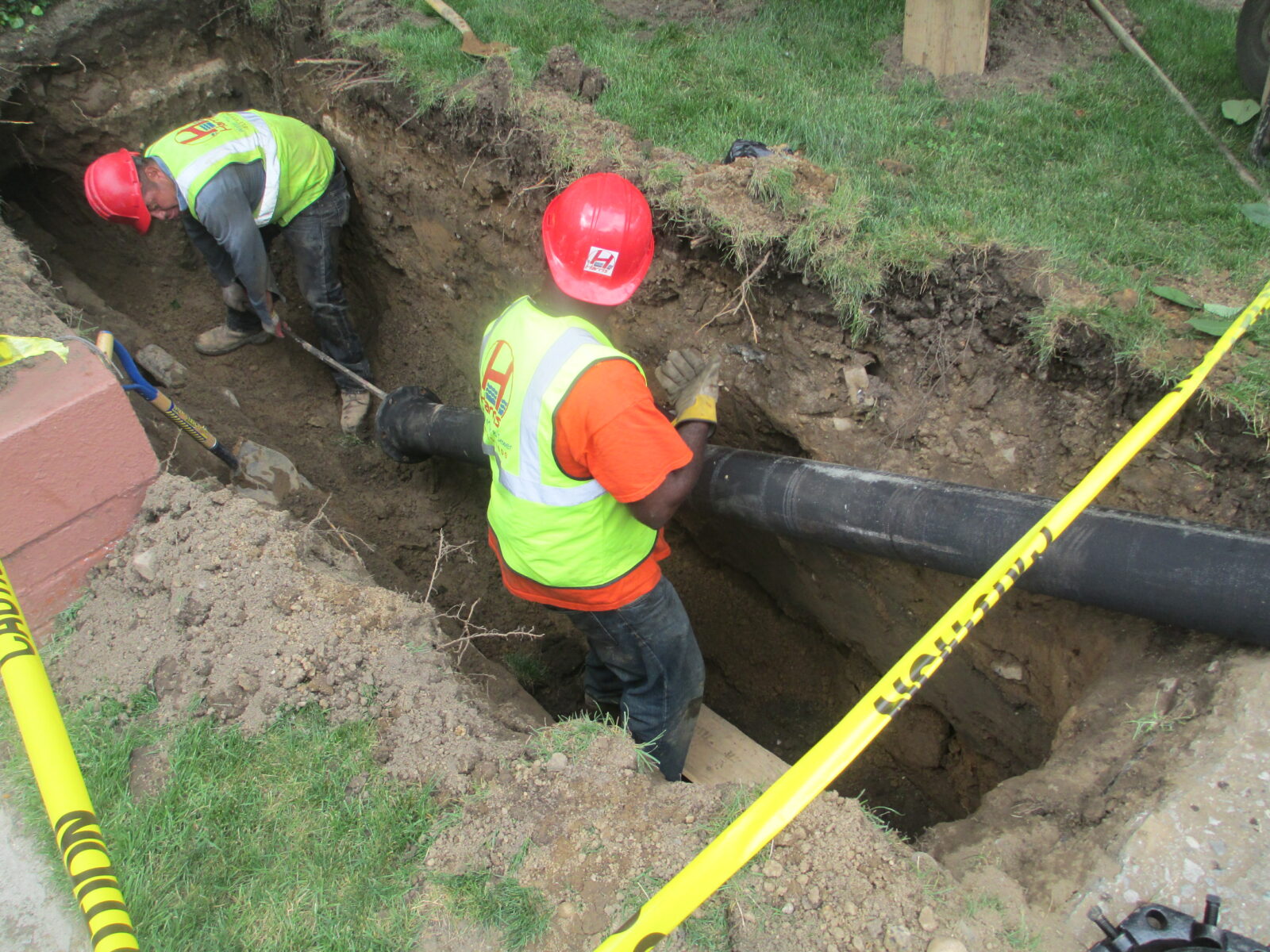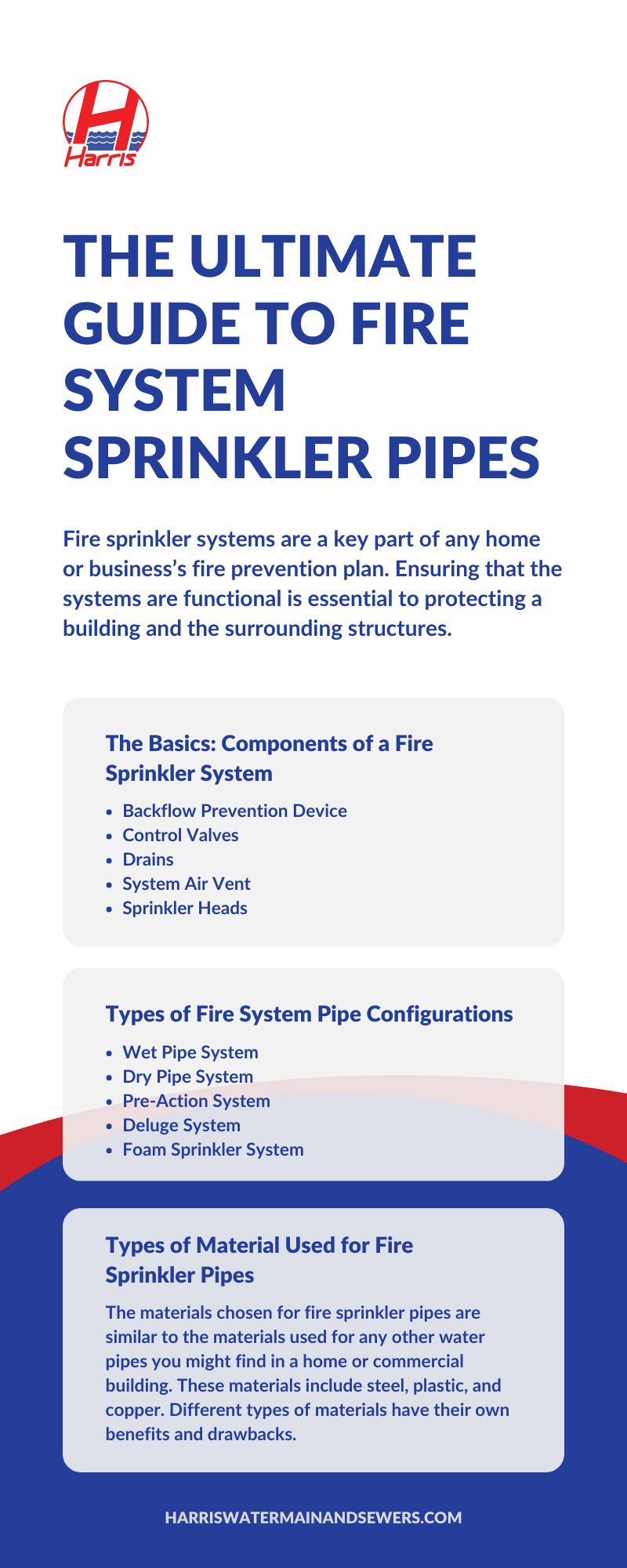Fire sprinkler systems are a key part of any home or business’s fire prevention plan. Ensuring that the systems are functional is essential to protecting a building and the surrounding structures. However, it can be difficult to maintain your system when you don’t know all the components that make up the system, especially the pipes.
To that end, we have compiled the ultimate guide to fire system sprinkler pipes to help promote understanding of these systems and overall fire safety.
The Basics: Components of a Fire Sprinkler System
The pipes of a fire system are only one component of the overall system. To better understand how they function and why it’s necessary to understand something of the rest of the system to understand its role within it.
Although there are some variations among different buildings, most fire sprinkler systems are composed of the following components.
- Backflow Prevention Device: A backflow prevention device helps prevent water from the sprinkler system from flowing back into the fire department or city’s water supply.
- Control Valves: Help control the flow of water from one part of a fire sprinkler system to another. In general, these valves should remain open at all times to prevent system failure.
- Drains: Help direct water out of the home or building after the system has discharged.
- Fire Department Connection: A point in the system that allows the fire department to add more water to the sprinklers.
- System Air Vent: A vent that helps release air that has become trapped in water pipes, preventing corrosion and false water flow alarms.
- Sprinkler Heads: The point where the water emerges from the pipes and into the building. In some systems, sprinkler heads contain a glycerin-filled bead that acts as a fire detection device.
A series of pipes connects the different components of the sprinkler system, and individual systems will have different types and configurations of fire systems pipes. The system determines the different types of fire sprinkler pipes.
Types of Fire System Pipe Configurations
Wet Pipe System
The wet pipe system of sprinklers is one of the most common for commercial and residential businesses alike. In this system, the pipes are constantly filled with water and lined with several sprinkler heads.
As mentioned, a sprinkler head contains a fire detection bead filled with a specially formulated compound that rapidly expands when exposed to heat. When they do, the glass bead bursts, which allows the water from the pipes to pour out through the sprinkler head closest to the fire. This will not set off the other sprinkler heads in the system.
Dry Pipe System
As the name suggests, a dry pipe system does not store water in its pipes the way a wet pipe system does. Rather, the pipes are usually filled with pressurized air or nitrogen. When the air is released from the pipes, the difference in pressure signals the system to allow the water into the rest of the pipes.
Dry pipe systems can be more expensive to install and take slightly longer to begin putting out the fire. However, the system is ideal for places that experience extremely low temperatures that could freeze the water in a wet pipe system.
Pre-Action System
A pre-action system is a type of dry pipe system that uses slightly more complex processes to activate. Like a standard dry pipe system, the pipes are filled with air instead of water and will only fill with water when exposed to heat.
However, the system has another valve that will keep the water from releasing automatically unless the heat continues to rise. This helps avoid the sprinkler system accidentally going off in the event of a damaged sprinkler head or air leak. This is important in buildings that house things prone to water damage, like museums, galleries, and places with a large amount of technological equipment.
There are three types of pre-action systems available, and each activates under different circumstances. These system types are:
- Non-interlocking pre-action systems: These systems release water as soon as the water fills the pipes.
- Single interlocking pre-action system: When these systems detect heat, the water fills the pipes. However, they won’t release water unless the temperature continues to rise.
- Double interlocking pre-action systems: These systems will not allow the pipes to fill with water until the temperature has reached higher levels; then the air and the water will release at the same time.
Deluge System
While a pre-action system is built to be used in scenarios where water can damage the materials in a building, deluge systems are ideal for buildings where a fire can get out of control very quickly. When a deluge system detects smoke or flames, all of its valves open at once, and every sprinkler head activates at the same time. This helps quell a fire before it gets out of control.
Foam Sprinkler System
Another option for locations where a fire can spread very quickly—such as a warehouse, an airforce hanger, or a place where people store flammable liquid—is to use foam sprinkler systems.
Along with the water pipes, this system also has a separately stored foaming agent within the system. This foam, called “firefighting foam,” is made up of small air bubbles and concentrate, which create a blanket that can smother fires almost instantly.
When the system detects a fire, it responds like a standard wet pipe system, releasing the water already stored in the pipes. But as the water is released, it mixes with the foaming agent, covering the ground in it to suppress the fires.
Types of Material Used for Fire Sprinkler Pipes
The materials chosen for fire sprinkler pipes are similar to the materials used for any other water pipes you might find in a home or commercial building. These materials include steel, plastic, and copper. Different types of materials have their own benefits and drawbacks.
For instance, copper pipes are more expensive to install, but they are highly durable and resistant to corrosion, making them last longer. On the other hand, steel is more cost effective but more prone to corrosion, which is especially noteworthy for wet pipe systems.
Harris Main and Sewers has been one of the top names in NYC fire sprinkler installation for over 100 years and is well equipped to install the sprinkler system in your property.






















